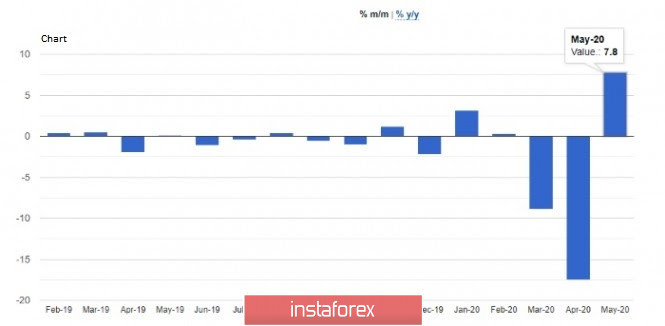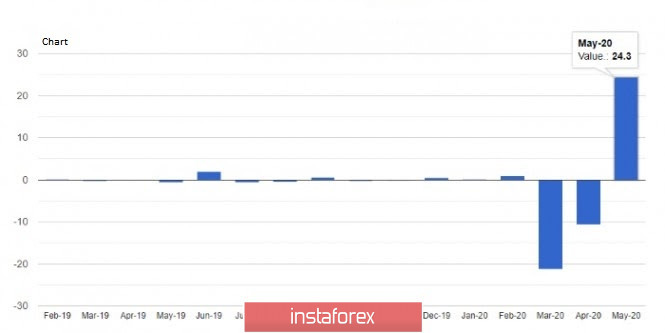The euro declined against the US dollar, and the British pound surged higher after the appearance of another rumor related to the secret Brexit negotiations. Pressure on the euro was exerted by today's reports on Germany, as well as the forecast of the European Commission, which was filled with one negative. However, the current movement of the euro/dollar pair is purely corrective, and so far, buyers of risky assets are still quite far from panicking.

Now let's look at the report on industrial production in Germany, which caused the fall of the European currency in the first half of the day. Even though the monthly growth rate has broken all records, serious problems for the German economy cannot be avoided. The data fell short of economists' forecasts, which suggests that a return to normal life will be quite difficult. Given the fact that orders also did not show strong growth, and it will be possible to make a full assessment of the damage from the coronavirus only in the late autumn of this year, it is rather premature to say that the recovery of the industry will remain at a high level. Most likely, the movement will be undulating, and much will depend on how Germany copes with the second wave of the epidemic.
According to the Federal Bureau of Statistics Destatis, in May of this year, due to the easing of quarantine measures, compared with April, industrial production in Germany increased sharply. The indicator includes an assessment of the manufacturing industry, energy, and construction. Thus, industrial production jumped immediately by 7.8%, while economists expected growth of 10%. Compared to May last year, industrial production decreased by 19.3%.
If we take the indicator separately by direction, manufacturing production in May increased by 10.3%, while the production of intermediate goods decreased by 0.1%. The main growth was in the capital goods sector by 27.6%, while consumer goods increased by only 1.4%.

It is already clear that a more active recovery of the Eurozone economy will require the adoption of the European Commission's proposed plan to stimulate the economy. However, this issue is unlikely to be raised until the meeting of EU leaders scheduled for July 17-18. If the agreement is approved, and Germany and other Northern countries do not become very resistant, given the latest macroeconomic statistics, the demand for the European currency may increase even more. Therefore, do not be surprised if the euro strengthens closer to the summit, even against the background of negative data, as many institutional investors will gain long positions on risky assets. However, any delay in negotiations is fraught with downside risks for both the Eurozone economy and the European currency.
Another unpleasant report was the forecast of the European Commission, according to which they revised their attitude to GDP for 2020. According to the data, economists now forecast a reduction in Eurozone's GDP in 2020 by 8.7%, whereas a little earlier it was only a reduction of 7.7%. As for Germany, it is the only country where the report was revised in a positive direction. The economy is expected to contract by 6.3% against 6.5% in 2020. Italy's GDP is likely to fall by 11.2% against 9.5%, while France's GDP will shrink immediately by 10.6% against the previous estimate of 8.2%.
The revision came after the initial analysis and response of these countries to the coronavirus pandemic after the opening of economies and the lifting of quarantine measures.
As for Italy, a report was released today, which indicated a sharp increase in retail sales after the gradual lifting of quarantine measures and the reopening of stores. According to statistics agency Istat, in May 2020, the retail sales index increased by 24.3%. The growth was mainly due to a sharp jump in non-food products by 66.3%. Meanwhile, the panic eased, and sales of food and essential goods fell by 1.4% compared to April.

As for the technical picture of the EURUSD pair, now a lot will depend on how traders behave at the level of 1.1270, which was formed today in the first half of the day after a sharp decline in the trading instrument against the background of negative fundamental statistics. If the bulls again show enough activity, as it was in the first half of the day, we can count on a repeated return of the EURUSD to the resistance of 1.1300 and its breakout, which will provide an influx of new buyers who can drive the euro to weekly highs to the levels of 1.1350.
Meanwhile, the British pound shot up after breaking through the 1.2520 resistance, which was the main focus of buyers in the first half of the day. The increase came after rumors that representatives of the UK and the European Union will soon hold informal trade talks. As you may remember, no significant progress was made last week, as the European side still insists on following common rules and standards in the field of trade. Likely, Prime Minister Boris Johnson may also take part in the informal meeting.
The material has been provided by InstaForex Company - www.instaforex.com